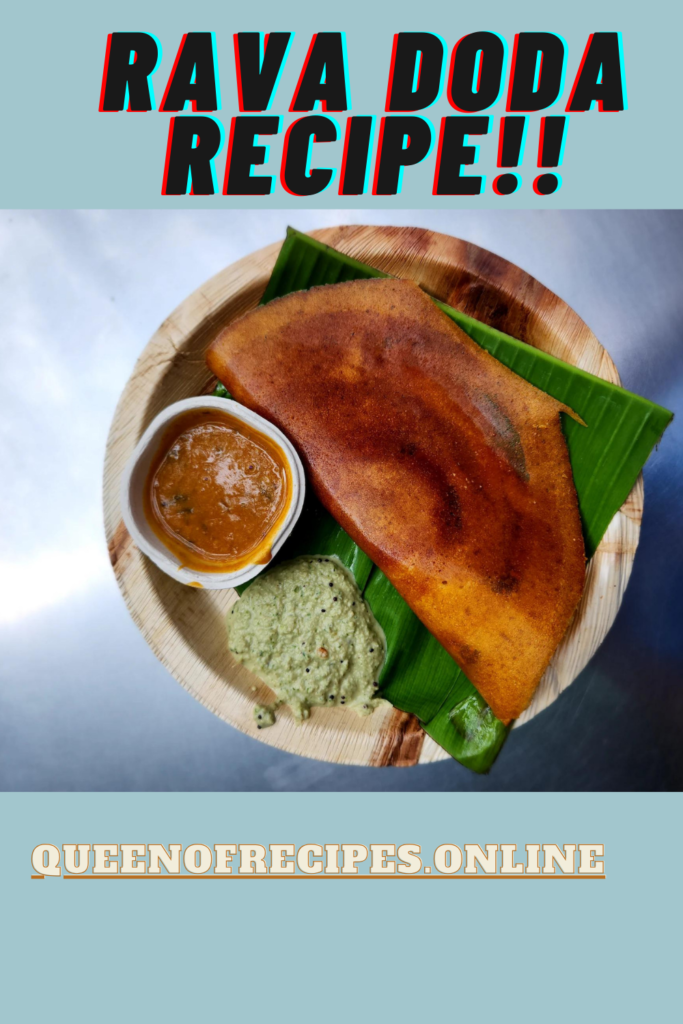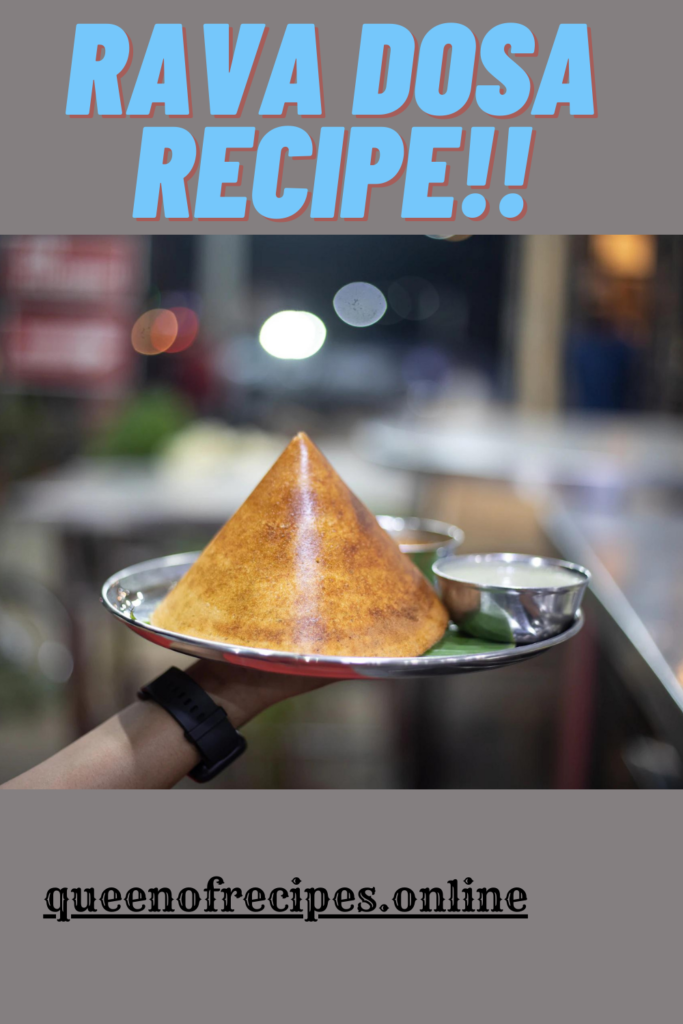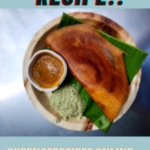Table of Contents
About Rava Dosa.
Rava Dosa is a popular South Indian crepe made from semolina (sooji or rava) and rice flour. What sets it apart from traditional dosas is its quick and easy preparation. Unlike regular dosas, Rava Dosa doesn’t require fermentation, making it a convenient choice for a delicious and crispy breakfast or snack option. The batter is typically a blend of semolina, rice flour, all-purpose flour (maida), and various seasonings, creating a thin, lacy, and slightly tangy dosa that pairs perfectly with coconut chutney, sambar, or a variety of side dishes.
Here’s how to make Rava Dosa at home:
Ingredients:
For the Dosa Batter:
- 1 cup semolina (rava or sooji)
- 1/2 cup rice flour
- 1/2 cup all-purpose flour (maida)
- 1/4 cup yogurt
- 2 cups water (approximately)
- 1/2 teaspoon cumin seeds
- 1/2 teaspoon black pepper
- 1-2 green chilies, finely chopped
- A pinch of asafoetida (hing)
- Salt to taste
For the Tempering:
- 2 tablespoons oil
- 1 teaspoon mustard seeds
- 1 teaspoon cumin seeds
- 1-2 green chilies, finely chopped
- 1 sprig curry leaves, chopped
- 1/2 teaspoon grated ginger (optional)
Instructions:
- Prepare the Batter:
- In a large mixing bowl, combine semolina, rice flour, all-purpose flour, yogurt, and water. Mix well until you get a smooth, lump-free batter. The batter should have a thin, pourable consistency, similar to buttermilk. Add more water if needed. Set it aside for 20-30 minutes.
- Add Seasonings:
- After resting, add cumin seeds, black pepper, finely chopped green chilies, asafoetida, and salt to the batter. Stir well to incorporate the seasonings.
- Prepare the Tempering:
- In a small pan, heat 2 tablespoons of oil. Add mustard seeds and cumin seeds. When they splutter, add the chopped green chilies, curry leaves, and grated ginger (if using). Sauté for a minute or until fragrant.
- Mix the Tempering:
- Pour the tempering into the dosa batter and mix thoroughly. The tempering adds a delicious flavor to the dosa.
- Make it:
- Heat a non-stick or cast-iron skillet or griddle over medium-high heat. You don’t need to grease the pan as the batter contains enough oil.
- Once the pan is hot, stir the batter well and pour a ladleful of batter onto the pan in a circular motion, starting from the outside and moving inward to create a thin, lacy dosa.
- Drizzle a few drops of oil around the edges of the dosa.
- Cook until the edges turn golden brown and the dosa becomes crispy. Rava Dosas are typically cooked only on one side, so there’s no need to flip them.
- Serve:
- Once the dosa is crisp and golden, remove it from the pan and serve hot with coconut chutney, sambar, or your favorite dosa accompaniments.
Enjoy your homemade Rava Dosa with its crispy texture and delightful flavors!


Nutritional Value.
The nutritional value of it can vary based on the specific ingredients and portion sizes used in the recipe. Here’s an approximate nutritional breakdown for a standard serving of Rava Dosa (one dosa without accompaniments):
- Calories: Approximately 150-200 calories per dosa.
- Carbohydrates: Around 30-35 grams, mainly from semolina (sooji), rice flour, and all-purpose flour.
- Protein: Roughly 4-6 grams, primarily from semolina and yogurt.
- Fat: Approximately 1-3 grams, which includes the oil used for tempering.
- Fiber: Minimal dietary fiber content.
- Vitamins and Minerals: It is not particularly rich in vitamins and minerals, but it does provide some essential nutrients from the ingredients used.
It’s important to note that the calorie and nutrient content can vary based on the thickness and size of the dosa, as well as the specific ingredients used. Additionally, the nutritional value can be influenced by the choice of accompaniments such as chutney, sambar, or other side dishes. For a more accurate assessment, it’s recommended to use specific brands and measurements when calculating nutritional values, especially if you have specific dietary requirements or restrictions.
Health Benefits.
Rava Dosa, like many South Indian dishes, offers several potential health benefits:
- Good Source of Carbohydrates: It is primarily made from semolina (sooji) and rice flour, which are excellent sources of carbohydrates. Carbohydrates provide energy for the body and are an essential part of a balanced diet.
- Protein Content: The yogurt and semolina in Rava Dosa provide a moderate amount of protein. Protein is crucial for muscle health, tissue repair, and overall growth.
- Low in Fat: It typically contains minimal fat, especially if you use a non-stick pan for cooking. This makes it a suitable option for those watching their fat intake.
- No Fermentation Required: Unlike traditional dosas, it doesn’t require fermentation, making it a quick and convenient choice. This is beneficial for those looking for a fast meal option.
- Digestibility: The semolina used in it is relatively easy to digest, and the tempering with spices can aid in digestion. However, if you have gluten sensitivity, it’s essential to use gluten-free semolina.
- Customizable: It is highly customizable. You can adjust the spiciness and seasoning to suit your taste, making it a versatile and enjoyable dish for a wide range of palates.
It’s worth noting that while it can be part of a balanced diet, its health benefits can vary based on the specific recipe and cooking methods used. For individuals with specific dietary considerations, such as gluten intolerance, it’s important to use gluten-free semolina and confirm the ingredients’ quality to align with their dietary requirements.
Tips and Trikes.
Creating the perfect Rava Dosa can be a bit challenging due to its unique texture and preparation method. Here are some tips and tricks to help you make a delicious and crispy Rava Dosa:
- Batter Consistency: Achieving the right batter consistency is crucial. The batter should be thin and pourable, like buttermilk. If it’s too thick, the dosa won’t spread well. Add water gradually while mixing to achieve the desired consistency.
- Resting Time: Allow the batter to rest for at least 20-30 minutes. This allows the semolina and flours to absorb the water and results in a smoother texture.
- Tempering: The tempering with mustard seeds, cumin seeds, curry leaves, and green chilies adds fantastic flavor. Ensure the oil is hot enough to sizzle the seeds when you add them.
- Hot Griddle: Heat the griddle or pan until it’s hot. To check if it’s ready, sprinkle a few drops of water on the surface; they should sizzle and evaporate. The hot surface helps create the lacy texture of the dosa.
- Don’t Over-Grease: You don’t need to grease the pan before making each dosa. The batter contains oil from the tempering, so use a minimal amount of oil for the first dosa and adjust as needed for subsequent ones.
- Thin and Lacy: Use a ladle to pour the batter in a circular motion, starting from the outer edge and moving inward. The dosa should be thin and lacy, with gaps.
- Cook on One Side: Unlike regular dosas, Rava Dosas are typically cooked only on one side. They don’t require flipping. Once the edges turn golden brown and the dosa is crispy, it’s ready to be served.
- Serve Hot: Rava Dosas taste best when served hot and crispy. They tend to lose their crispiness as they cool, so serve them immediately.
- Experiment with Fillings: While the traditional Rava Dosa is plain, you can get creative by adding fillings like chopped onions, cilantro, or grated cheese for additional flavor.
With practice, you’ll master the art of making the perfect Rava Dosa, and you can enjoy this crispy, South Indian delicacy with your favorite chutney or sambar.


serving Suggestions.
Rava Dosa is a delicious and crispy South Indian dish that is typically served with a variety of accompaniments to enhance its flavors. Here are some serving suggestions:
- Coconut Chutney: Coconut chutney is a classic accompaniment for Rava Dosa. It’s made with fresh coconut, green chilies, ginger, and other seasonings. The cool and creamy texture of the chutney complements the crispy dosa.
- Sambar: Sambar is a flavorful South Indian lentil and vegetable stew that pairs wonderfully with Rava Dosa. It adds a delicious savory and tangy element to the meal.
- Tomato Chutney: Tomato chutney is a tangy and spicy condiment made from tomatoes, chilies, and spices. It provides a zesty contrast to the dosa’s crispiness.
- Mint Chutney: Mint chutney is a refreshing and herby accompaniment that complements the dosa’s flavors. It’s made with fresh mint leaves, green chilies, and yogurt.
- Vegetable Curry: You can also serve Rava Dosa with a flavorful and mildly spiced vegetable curry. This adds a hearty component to the meal.
- Potato Bhaji: A simple potato side dish or “bhaji” made with spices and sautéed potatoes is a delightful option. It provides a bit of substance and complements the dosa’s texture.
- Ghee: Drizzle some ghee (clarified butter) over the dosa to enhance its taste. Ghee adds a rich, buttery flavor to the crispy dosa.
- Pickles: Some people enjoy Rava Dosa with a side of spicy Indian pickles or achaar. The combination of the dosa’s crispiness and the pickle’s tangy heat can be quite satisfying.
- Yogurt: A small bowl of fresh yogurt can also be a refreshing addition. It provides a cooling contrast to the dosa’s spiciness.
Remember that the choice of accompaniments is highly customizable and based on personal preferences. You can mix and match these options to create a delightful and well-rounded meal. Enjoy your Rava Dosa with the accompaniments of your choice.
FAQs.
Is Rava Dosa the same as regular dosa?



Rava Dosa is distinct from regular dosa in several ways. While both are popular South Indian dishes, they differ in their preparation and texture.
Rava Dosa does not require fermentation, making it a quick and convenient option. It is made from a batter consisting of semolina (sooji), rice flour, and all-purpose flour, along with yogurt and various seasonings. The absence of fermentation gives Rava Dosa its characteristic crisp and lacy texture, setting it apart from traditional dosa, which relies on a fermented batter of rice and lentils. Furthermore, Rava Dosa offers a unique and delightful flavor profile, making it a popular choice for those who crave a quick and crispy South Indian crepe.
What are the essential ingredients for Rava Dosa?



The essential ingredients for making Rava Dosa include:
Semolina (Sooji/Rava): Semolina is the primary ingredient and gives Rava Dosa its characteristic texture and crispiness.
Rice Flour: Rice flour is used to enhance the crispness and texture of the dosa.
All-Purpose Flour (Maida): All-purpose flour is added to help bind the ingredients and create the unique lacy pattern in the dosa.
Yogurt: Yogurt adds a slight tanginess to the batter and helps in the fermentation-free preparation.
Water: Water is used to achieve the right consistency of the batter. The batter should be thin and flowing.
Tempering Ingredients: A tempering of mustard seeds, cumin seeds, curry leaves, and green chilies is used to infuse the batter with flavor.
Salt: Salt is added for seasoning, and it enhances the taste of the dosa.
Oil or Ghee: A small amount of oil or ghee is used to grease the griddle and provide a touch of richness.
These ingredients come together to create a quick and delicious Rava Dosa with its signature crispy and lacy texture. Additional variations can include ingredients like chopped onions or other spices for added flavor.
Can I store Rava Dosa batter?



While it’s best to use Rava Dosa batter immediately after preparing it for the freshest and crispiest dosas, you can store it for a short period if needed. If you have leftover batter, you can refrigerate it for a day or two in an airtight container. However, keep in mind that the batter may thicken over time, so you may need to adjust the consistency by adding a bit of water before using it. It’s essential to maintain the batter’s flowy consistency to achieve the characteristic lacy texture of Rava Dosa. Additionally, make sure to mix the batter well before making dosas if it has been refrigerated.
What are the common variations of Rava Dosa?



Rava Dosa offers a versatile canvas for various delicious variations. Here are some common ones:
Onion Rava Dosa: Chopped onions are added to the batter, imparting a sweet and savory flavor and a delightful crunch.
Masala Rava Dosa: This variation involves stuffing the Rava Dosa with a spiced potato filling. It combines the crispy texture of Rava Dosa with the rich and flavorful potato masala.
Green Chili Rava Dosa: For those who enjoy some heat, this version includes finely chopped green chilies in the batter, adding spiciness to each bite.
Paneer Rava Dosa: Grated paneer (Indian cottage cheese) can be sprinkled on top of the dosa for a creamy and protein-rich twist.
Tomato Rava Dosa: Tomato chunks or puree can be added to the batter for a tangy and refreshing flavor.
These variations allow you to customize Rava Dosa to your taste preferences, making it a versatile and popular South Indian dish.

